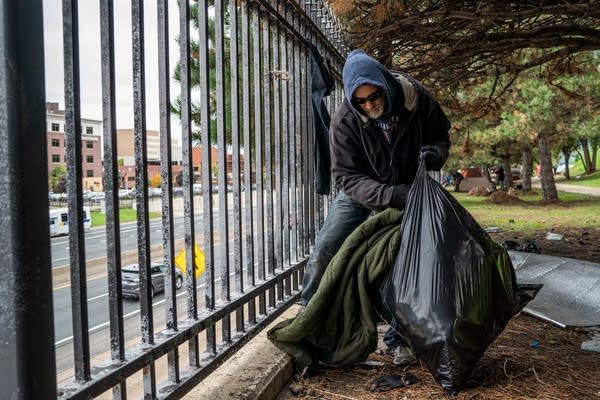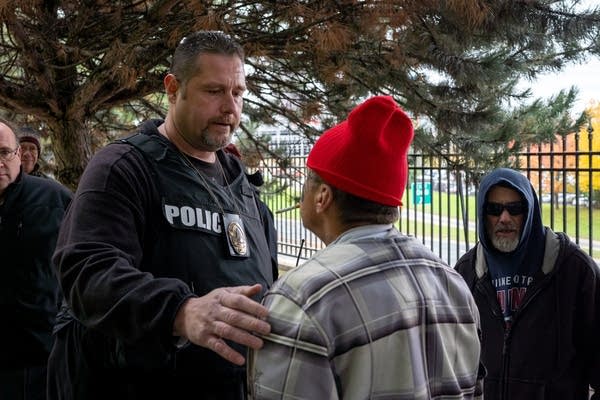Homeless camp next to I-35E in St. Paul can continue, officials say

Go Deeper.
Create an account or log in to save stories.
Like this?
Thanks for liking this story! We have added it to a list of your favorite stories.
Marty Thomas has been homeless on and off for about three years.
"I have a few family left here, but not that much, and they got their own thing, so I'm down here because of a series of bad breaks in my life," he said.
Thomas spent Thursday morning cleaning up where he and a friend have been camping, at Interstate 35E and Kellogg Boulevard. As he packed up his tent and belongings, he said he knew that city and county crews were coming to clear out the site for the second time in two days, but Thomas wasn't sure if they would be kicked out for good.

"We're trying to work with them as much as they're trying to work with us, but ultimately I don't understand their bottom line," he said. "I don't know what they want. No one's told us that yet."
Turn Up Your Support
MPR News helps you turn down the noise and build shared understanding. Turn up your support for this public resource and keep trusted journalism accessible to all.
Around two dozen people have been camping out on a strip of Minnesota Department of Transportation-owned land, which sits above I-35E and down the hill from the St. Paul Cathedral. The encampment has grown slowly over the last few months along both sides of a sidewalk, and also has become more visible.
Some people are on wait lists to get into shelters, which they say are full. Others say they have been kicked out for violating rules or choose the comparative freedom of living outside.
There are people who have been living in tents for a long time and others who are new to the place, said Alan Ostergaard, a street outreach practitioner with Outside In, in St. Paul. He's worried about novice campers.

"Like this morning we were up here talking to people and it was snowing and nobody is really prepared for that with the weather and they don't really know how to be safe in that kind of weather," Ostergard said.
Over the last several months, the city and county have been trying to find a balance on how to deal with the encampment. Ostergaard said they started out with a tougher stance.
"It was a, 'You gotta move or we're going to tear down your stuff.' That heavy-handedness didn't seem to be effective, so that led to the non-enforcement," he said. "If we just keep kicking people out of their campsites and then they get scattered in the wind, then it's really hard for service providers, like outreach workers to actually get people into housing and services," he said.
Instead, the city, county and public outreach agencies try to strike a balance.
"It's a difficult line to walk and really this [Mayor Melvin Carter's] administration is being thoughtful and deliberate about the actions we take out here," said Travis Bistodeau, the deputy director of St. Paul's Department of Safety and Inspections. "We recognize that most of the folks out here have nowhere else to go and we're trying to make it safe for them to stay here, while balancing the needs of the neighborhood as well."

Early Thursday afternoon, two dozen police, city, MnDOT and Ramsey County workers rolled up to the encampment with garbage bags, buckets and a small front loader. They picked up trash, grabbed some bike frames left along fences and boards that had been used by campers. All of it was taken away. They've done this about once a week for the last few months.
But Thursday was the second time in two days government crews had been to the site to clean up the encampment. The later cleaning was more intense: campers had to move their tents, some in place for two weeks — to clean the entirety of the grounds.
"We're really trying to make an effort to clean the site and make sure it stays safe and sanitary for the occupants," Bistodeau said. "But once it's clean, they'll be free to reoccupy the site as needed."
Bistodeau said a coalition of city, county and nonprofit leaders in Ramsey County have been working on longer term solutions to the homelessness problem.
Correction (Oct. 12, 2018): An earlier version of this story incorrectly identified Alan Ostergaard.



